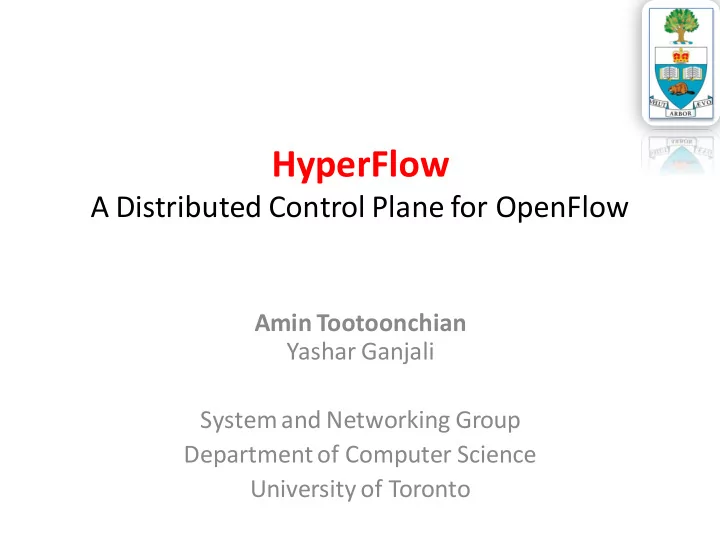

HyperFlow A Distributed Control Plane for OpenFlow Amin Tootoonchian Yashar Ganjali System and Networking Group Department of Computer Science University of Toronto
Brief Overview of OpenFlow • Root cause of network mgmt. & control complexity: – Tight coupling of control and data planes. • separates the data and control planes: – Abstracts switches as programmable flow tables. – A logically centralized controller programs them. • But current setups do not scale well. OpenFlow extremely simplifies network control & mgmt. April 27, 2010 HyperFlow - University of Toronto 2
A Network with a Single Centralized Controller Does Not Scale. • Flow setup time for switches farther from controller is larger. • Single controller can handle a limited number of datapath requests. • End-to-end control bandwidth is limited. Network operators need to deploy multiple controllers. April 27, 2010 HyperFlow - University of Toronto 3
Distributed Control Plane Must Not Sacrifice Simplicity for Scalability! • Key to OpenFlow’s simplicity: • Network control logic centralization. • Trade-off: • Scalability (complete distribution) • Simplicity • Distributed cp should be scalable, yet transparent to the control logic. A distributed cp must keep network control logic centralized. April 27, 2010 HyperFlow - University of Toronto 4
Our Approach: Push All State to All Controllers • Make each controller think it is the only controller. • Passively synchronize state among controllers. – With minor modifications to applications. • How to synchronize state with minimal modification? – Capture controller events which affect controller state. • Controller events: e.g., OpenFlow messages (Packet_in_event , …). • The number of such events is very small. – Replay these events on all other controllers. April 27, 2010 HyperFlow - University of Toronto 5
HyperFlow Design • HyperFlow has two components: – Controller component: • An event logger, player, and OpenFlow command proxy. • Implemented as a C++ NOX application. – Event propagation system: • A publish/subscribe system. • Switches are connected to close controllers. • Upon controller failure: – Switches are reconfigured to connect to another controller. April 27, 2010 HyperFlow - University of Toronto 6
Overview of HyperFlow April 27, 2010 HyperFlow - University of Toronto 7
HyperFlow Controller Component • Event logger captures & serializes some ctrl events. – Only captures events which alter the controller state. – Serializes and publishes the events to the pub/sub. • Event player deserializes & replays captured events. – As if they occurred locally. • Command proxy sends cmds to appropriate switch. – Sends the replies back to the original sender. April 27, 2010 HyperFlow - University of Toronto 8
Event Propagation System • The pub/sub system has a network-wide scope. • It has three channel types: – Control channel: controllers advertise themselves there. – Data channel: events of general interest published here. – Individual controllers’ channels: send commands and replies to a specific controller. • Implemented using WheelFS, because: – WheelFS facilitates rapid prototyping. – WheelFS is resilient against network partitioning. April 27, 2010 HyperFlow - University of Toronto 9
Are Controllers in Sync? • How rapidly can network changes occur in HF? – Yet guarantee a bounded inconsistency window. • The bottleneck could be either: – The control bandwidth. – The publish/subscribe system. • The publish/subscribe system localizes the HyperFlow sync traffic. – The control bandwidth problem could be alleviated. How many events can HF exchange with pub/sub per sec? April 27, 2010 HyperFlow - University of Toronto 10
How Frequent Can a Network Change? • Benchmarked WheelFS: – The number of 3KB-sized files HF can serialize & publish: • 233 such events/sec not a concern (multiple publishers) – The number of 3KB-sized files HF can read & deserialize: • 987 such events/sec. • However, HF can handle far larger number of events. – During spikes inconsistency window is not bounded. Switch/Host/Link 10s of events/sec for changes thousands of hosts No. of network changes on avg must be < 1000 events/sec. April 27, 2010 HyperFlow - University of Toronto 11
Summary • HyperFlow enables deploying multiple controllers. – Keeps network control logic centralized. – Yet, provides control plane scalability. • It synchronizes network-wide view amongcontrollers. – By capturing, propagating & playing a few ctrl events. • It guarantees bounded window of inconsistency: – If network changes occur at a rate < 1000 event/sec. • It is resilient to network partitioning. • It enables interconnection of OpenFlow islands. April 27, 2010 HyperFlow - University of Toronto 12
Current/Future Work • We designed OpenBoot to bootstrap controller state very quickly. – Uses checkpoint/restart + event logging – Enables rapid recovery from controller failures. – Enables adaptive control plane scaling. – Enables continuous control plane operation. • Improvements to the publish/subscribe system. • Evaluation on a large testbed with realistic data. April 27, 2010 HyperFlow - University of Toronto 13
Thanks for your attention. Questions? amin@cs.toronto.edu
Recommend
More recommend